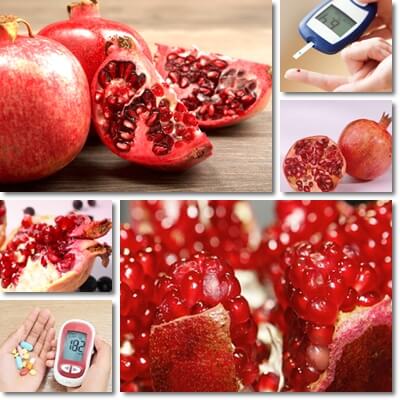Yes, you can eat pomegranate with diabetes in limited amounts, as part of a clean, balanced and varied diet, suited to your individual nutritional requirements and the restrictions of your condition. While nutritious and an overall healthy addition to almost any diet, including a diabetic diet, there are also contraindications to the consumption of the fruit. The main disadvantages of pomegranate in diabetes are the high carbohydrate and relatively high sugar content which restrict intake to small amounts. Also, while diabetics can eat raw pomegranate seeds, they are advised to avoid pomegranate juice, syrup and molasses which contain high to excessive amounts of sugar, both naturally occurring and added, and lack some of the nutrients essential to slowing down the absorption of sugar into the bloodstream.
The main edible part of the fruit are the juicy, red seed coats or arils, inaccurately called pomegranate seeds because of their resemblance to seeds (see Properties and Benefits of Pomegranate seeds, the real ones). The actual seeds are enclosed in the juicy, red arils and are usually not eaten, but instead used to produce a high-quality unrefined, cold-pressed oil (see Properties and Benefits of Pomegranate Seed Oil). Other parts of the fruit are used in various preparations, but usually not meant to be consumed as food. The seeds, rind and flowers may be boiled down to a non-edible (external use only) essential oil for skin and hair care. The seeds may be ground to obtain a powder that is consumed as a nutritional supplement and so on.

The pomegranate fruit in diabetes is neither good, nor bad: its effects are determined based on how much of the fruit you eat and how often. A diabetic patient must consider the sugar, fiber and carbohydrate content as well as the glycemic index of the fruit (meaning how fast or slow the sugar from the fruit will be absorbed into the bloodstream and whether or not it will cause blood sugar spikes). Other factors may recommend or advise against the consumption of the fruit in certain amounts, such as current weight and health status, including existing complications, the diabetic patient’s ability to manage their condition as well as whether the patient has diabetes type 1 or diabetes type 2, the first being somewhat more difficult to manage.
How many carbs and how much sugar in pomegranate seeds?
Note: The term seeds or pomegranate seeds is used in the following lines to refer to the arils, seed coats or seed sacs containing pulp and juice.
Carbohydrate, sugar and fiber content: 18.7 g of carbs per 100 g of seeds, of which 13.67 g are sugars and 4 g are fiber.
16.27 g of carbs per cup of seeds (estimated at 87 g), of which 11.89 g are sugars and 3.5 g are fiber.
Except for fiber which is a structural carbohydrate and isn’t digested (it passes unchanged through the digestive tract), almost all of the carbohydrate content of the fruit is made up of simple sugars which are digested fairly quickly and absorbed just as quick into the bloodstream, raising blood sugar levels. Eating too much, which could mean even 1 cup of seeds for some diabetics, can easily cause spikes in blood sugar levels. Also, pomegranates differ in their sweetness and thus sugar content may vary from fruit to fruit so you need to consider this aspect as well when determining how much you can eat.
Interestingly, pomegranate generally has less sugar than figs and grapes and slightly more than cherries, dessert bananas, pineapple and watermelon. Despite this, it’s actually a better option for diabetes than pineapple and watermelon because it has lots of fiber and a low glycemic index, which means the sugar in it is absorbed at a slower rate compared to the sugar in the two other fruits. However, you still have to limit your intake to small amounts. See Can You Eat Watermelon With Diabetes?

Pomegranate glycemic index (low, below 55)
The glycemic index is a scale that measures how fast the sugar resulting from various plant foods raises blood sugar levels. Below 55 is a low glycemic index. Between 55-69 is a medium glycemic index. Between 70- 100 is a high glycemic index. Because it has a low glycemic index, below 55, it can be said that pomegranate benefits diabetes more than pineapple and watermelon do. See Can You Eat Pineapple With Diabetes? And this is all a result of the fiber content of the seeds which slow down the absorption of sugar into the bloodstream and prevent blood sugar spikes.
Energetic value: 77.93 kcal per 100 g of seeds. Most of the calories in the seeds come from carbohydrates and since the majority of digestible carbohydrates are simple sugars, most of the calories thus come from sugars. Fortunately, the seeds have a moderate energetic value and can be eaten in a diabetic diet in small amounts without fear of weight gain. Weight management is a crucial aspect of diabetes and represents the best tool to avoid long-term complications such as high blood pressure, high cholesterol and heart disease.
What are some of the benefits of pomegranate for diabetes?
1) Doesn’t raise blood sugar levels because of its good fiber content, but only when consumed in limited amounts, as part of an overall clean, balanced and varied diet.
2) Boosts immunity as a result of vitamin C and antioxidants.
3) Benefits for wound healing as a result of the immune function enhancing effects of vitamin C and antioxidants.
4) Low in fat (1.17 g/100 g of seeds) and calories (77.93 kcal/100 g), but rich in fiber, it helps maintain a steady weight and even promote weight loss and a healthier blood cholesterol profile, with major benefits for diabetes management.
5) Lower risks of coronary heart disease thanks to good amounts of vitamin B9.
6) Minor benefits for blood pressure and general cardiovascular health from potassium, magnesium and vitamin C, all found in small to moderate amounts in the fresh seeds.
7) Improved skin appearance and health as a result of B vitamins (B1, B2, B3, B5, B6, B9 and vitamin E).
8) Tonic, energizing effects as a result of overall nutritional profile, supports physical activity.
9) Combats fatigue caused by anemia as a result of vitamins B9 and C.
10) Good for pregnant women thanks to vitamin B9 which combats anemia in pregnancy and helps prevent birth defects.
Pomegranate in gestational diabetes
The main reason why pomegranate is recommended by some in gestational diabetes is because of its good vitamin B9 content. Vitamin B9 or folate helps with brain and nervous system development of babies in the womb and prevents neural tube defects of the brain, spine and spinal cord. It also helps reverse and manage anemia caused by vitamin B9 deficiency and counteracts fatigue. Moreover, the vitamin has a direct and beneficial action on homocysteine levels and helps prevent damage to the inside of artery walls and narrowing of the arterial wall, with benefits for cardiovascular health. Small amounts of potassium and magnesium further help lower high blood pressure.
Tips on how to eat pomegranate safely with diabetes
1) Never eat fruits on an empty stomach. Always after a light protein or low carbohydrate meal.
2) It’s best not to eat more than 1 serving of a fruit a day.
3) Weigh your fruit serving and determine its content of carbohydrates and sugar to make sure you don’t exceed your daily intake of carbs and sugar.
4) Plan ahead for eating a fruit: plan your meals according to their protein and carbohydrate content so you can include a serving of fruit as dessert.
Diabetes and pomegranate juice
While there are studies that confirm drinking pomegranate juice helps diabetes in the sense that it boosts immune function, improves blood cholesterol profile and prevents artery damage and heart disease, the amounts consumed for such effects to become visible may be excessive for a diabetic, especially one with poor control of their condition. The unsweetened juice concentrates important amounts of sugar, while the sweetened commercial juice has added sugars. Without the fiber from the seed coats, there is nothing to prevent spikes in blood sugar levels with even small amounts of juice.
Diabetes and pomegranate molasses and syrup
Pomegranate syrup is essentially juice with added sugar that is reduced by boiling. And pomegranate molasses is an even thicker syrup obtained by boiling down pomegranate juice with sugar or syrup. By their very nature, these two products contain excessive amounts of sugar and hold no real benefits for a diabetic (boiling even destroys vitamin C).
Diabetes and pomegranate extract
There is no major, visible benefit for diabetes that you can get from a pomegranate extract that you can’t get from eating right, exercising, managing your weight and taking your medication. You are actually more likely to reverse a type 2 diabetes with a good diet, exercise routine and weight management than you are ever going to be with (just) an extract of anything. You can turn to supplementation to support your efforts, but that doesn’t eliminate the need to eat right, exercise, manage your weight and take your medication.
Most extracts are usually made from seeds and are edible in very limited amounts. However, always check the label to see if there is anything you might not have been aware of that could somehow impact your condition in a negative way.
Conclusion
Can diabetics eat pomegranate? Yes, diabetics can eat raw pomegranate seeds in limited amounts, as part of an overall clean, varied and balanced diet, suited to their individual nutritional requirements and the restrictions of their condition. Pomegranates are actually good for diabetes because they have a low glycemic index and contribute to better blood sugar control. The nutritional profile of the seeds further provides benefits for wound healing, cardiovascular health and energy metabolism. However, it’s important to remember that pomegranate helps diabetes to a limited extent and is not going to reverse bad eating habits or cure anything by itself, hence the importance of one’s diet as a whole.
